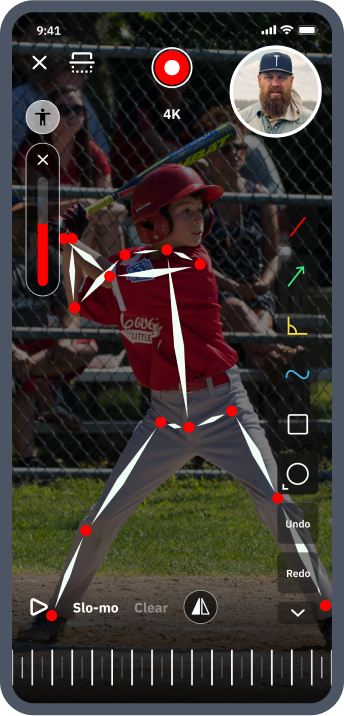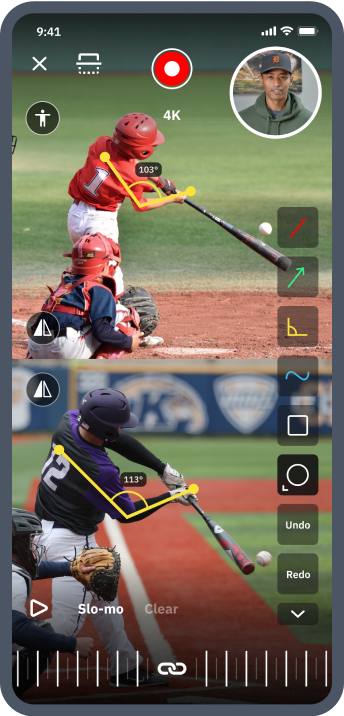How Young is “Too Young” to Start Strength Training for Baseball & Softball? | The Ultimate Evidence-based Guide for Parents and Coaches

What’s the right age to start strength training for baseball and softball athletes?
Many parents and coaches ask this question, or similar ones, related to strength and resistance training for their young athletes.
They might worry about a potential risk for injury or underdevelopment if a kid starts strength training too soon.
In reality, strength training can be beneficial to both children and adolescents when done properly and supervised by a professional.
Strength training can actually help reduce the risk of injury among young ballplayers. As for a good age to start, it depends on each individual’s growth and maturation.
But let’s not get ahead of ourselves – we’ll cover growth, and the benefits of strength training for ballplayers, in much more detail within this article.
Here’s a breakdown of what’s to come:
- Overview of youth strength training
- The importance of working with qualified professionals
- Reducing sports-related injury risk in youth ballplayers
- The benefits of resistance training for children and adolescents
- The risks of strength training at a young age
- Chronological age vs. physical maturity – when to start training?
Overview of Youth Strength Training
In the last several years, kids have started entering competitive sports at a higher rate than before. And they have also begun specializing in a given sport much earlier.
As a result, many prepubescent children have started strength or resistance training programs to be in better shape for their chosen sport.
Some parents and coaches have concerns about the safety of young children doing strength training. Many of these worries around stunted growth and injuries have been around for so long that they feel like common sense.
Endorsements for youth strength training:
- The National Strength and Conditioning Association (NSCA) in the U.S. supports the idea that adult resistance training programs can be beneficial to children and adolescents who follow age-specific programs
- The U.S. Secretary of Health and Human Services encourages children to engage in proper muscle-strengthening exercises in its Physical Activity Guidelines Advisory Report
- The American College of Sports Medicine believes strength training to be beneficial and safe for young children when done correctly
- The Australian Strength and Conditioning Association contends that if a child is old enough to participate in organized sports, they are old enough to start strength training
- The American Academy of Pediatrics, the International Federation of Sports Medicine, the North American Society for Pediatric Exercise Medicine, the Chief Medical Officer of the National Collegiate Athletic Association, and several other groups endorsed the position that strength training can improve health outcomes for children
- The World Health Organization supports resistance training for youth and adolescents in their 2010 Global Recommendations on Physical Activity for Health
As is hopefully obvious by now, several of the world's most prominent national and international organizations both support and promote strength training for children and adolescents.
But before continuing, let’s all get on the same page terminology-wise.

Important strength training terms for parent and coaches to know
Before discussing the benefits of strength training, it’s important to clarify what “resistance training” and “weightlifting” are.
These terms are often used interchangeably but aren’t necessarily the same thing.
- Resistance training: Resistance training is a specialized method of physical conditioning in which an individual works against a wide range of resistive loads to enhance health, fitness, and performance.
Examples include exercises using bodyweight, weight machines, free weights, elastic bands, and medicine balls. Resistance training may also be referred to as “strength training” – and will be for most of this article. - Weightlifting: Weightlifting is an actual sport involving lifting barbells or other heavy weights.
It often involves two standard lifts. The first is the snatch – a single-movement lift from floor to extended position. And the second is clean and jerk – a two-movement lift from floor to shoulder, then from shoulder to extended position.
Weightlifting may comprise part of an overall resistance training program, but kids can also complete effective strength training without lifting weights.

Some other important terms to know include:
- Training age: the number of years a person has been involved in a structured training program
- Maturation: progressive overall change within the human body from childhood to adulthood, which influences overall physical performance capabilities
- Growth: quantifiable change in body composition or size
It’s important to distinguish between maturation and growth, because the starting age for strength training will depend on the difference between these two factors.
Okay, now that our terms are straight, let's jump right in with both feet.
Unlock your ballplayer’s full potential
Find the perfect vetted coach to build a solid foundation or take your player's skills to new heights.
Download the free app

Integrative Neuromuscular Training
If children start strength training, it’s important that they follow a program suited to their current abilities.
One well-thought-out type of training put forward by Myer, Faigenbaum, Ford, Best, Bergeron, and Hewett is called integrative neuromuscular training (INT).
INT focuses on safe, effective, and enjoyable strength and conditioning programs for children ages 7-12.
INT incorporates general and specific conditioning activities, including:
- Fundamental movements
- Exercises targeting motor control deficits
- Resistance training
- Dynamic stability exercises
- Core focused training
- Plyometric drills
- Agility training
INT combines health-related physical fitness, such as muscular strength and body composition, and skill-related physical fitness, such as reaction time and coordination.
Myer et al. consider INT a cornerstone of strength training for children (ages 7-12) and for adolescents (ages 13-18).
Muscular strength is a prerequisite for building motor skills. And INT is vital to young children because developing strength, reaction time, speed, balance, and coordination is a necessity for an active lifestyle later in life.
This training lays a solid foundation of health that extends into adulthood. But these motor skills are also essential for children who want to start playing sports like baseball and softball at a young age.

The Importance of Working with Qualified Training Professionals
Parents and coaches considering a resistance training program for their children should always seek out qualified professionals.
According to Lloyd RS, Faigenbaum AD, Stone MH, et al., these individuals are trained in pediatric sports medicine, and aware of the unique physiological, physical, and psychosocial needs of children and adolescents.
Such a professional might carry certification with the NCSA as a Certified Strength and Conditioning Specialist, or a similar qualification from another accredited association.
Besides the requisite certifications, here are some other things to look out for:
- A qualified professional would also be knowledgeable of the different methods of communication and interaction necessary to teach or coach children.
- They’ll have the expertise to plan and progress age-related resistance training programs to youth, and adapt these programs to individual needs when necessary.
- They’ll also agree to work with other healthcare practitioners, such as certified athletic trainers, registered dietitians, and local youth sports coaches, to boost the child’s overall health and wellbeing.
Why is working with someone well-trained so important for youth strength training?
Besides the obvious, it’s important to keep in mind that positive experiences in physical education early in life have been associated with lifelong physical activity.
And lifelong physical activity is a cornerstone of a healthy and productive life.
Secondly, qualified professionals can ensure a child does age-appropriate exercises without risking injury.
You want your professional trainer employing research-backed approaches, such as the Youth Physical Development (YPD) model.
All the evidence showing the benefits of resistance training for children also shows that the training isn’t effective without the right instruction.
Luckily, connecting young ballplayers to qualified pros both locally and remotely is what platforms like ours were built to do.

Reducing Sports-Related Injury Risk in Youth Athletes
Resistance training can help prevent sports-related injuries in children and adolescents.
Each year, more than 2.6 million athletes aged 0-19 receive emergency room medical treatment for sports and recreation-related injuries in the U.S.
Some common risk factors that lead to injury include dehydration or heat exhaustion, overuse, head injuries from lack of protective gear, and being overweight or obese.
In fact, overweight adolescents are more than twice as likely to be injured in sports than their peers who aren’t overweight.
Helping reduce injuries from obesity
Some of these risk factors can be addressed with relatively short term solutions, such as drinking more water, taking rest days, and wearing protective equipment.
However, overcoming being overweight or obese takes a longer-term fix – such as consistent resistance training often accompanied by dietary changes.
A holistic training program that includes resistance training can improve muscle strength and enhance motor coordination in overweight and obese children, who, on average, have poorer motor skills compared to their peers.
Helping reduce overuse injuries
Resistance training can also help prevent overuse injuries in young athletes as well.
Overuse injuries tend to emanate from three major risk factors:
- Low fitness level
- Muscle imbalances
- Errors in training
Supervised resistance training programs that address these risk factors can potentially reduce overuse injuries in children and adolescents by almost 50 percent.
Overuse injuries, in particular, are plaguing youth baseball pitchers at increasingly alarming rates. If your ballplayer takes the mound on occasion, then our ultimate parents’ guide to preventing arm injuries is can’t miss.
But training programs that incorporate functional abilities, movement mechanics, and muscle strength are some of the most effective strategies for preventing injury.
The earlier these programs start, the less likely kids are to develop muscular deficits as well. The right kind of training program can also help ease a young child’s start in competitive sport.
Because of the significant potential for injury prevention, children participating in more than one sport or more than one league should view resistance training sessions not as extra but as a necessary part of participating in any competitive sport.
That last bit is so important that it bears repeating.
Taking a macro look at the history and adoption of strength training in our sports of baseball and softball is quite interesting and worth a small detour here.
Compared to other popular American sports like football, for example, baseball and softball coaches, players, and parents were a bit slower to realize the inescapable importance that strength training has on both an athlete’s durability and their in-game success.
Exploring the potential reasons for this fact would require its own dedicated article.
But the important thing here is that, luckily, the genie is finally out of the bottle, and almost everyone realizes that strength training should be viewed as part of being a ballplayer the way that playing catch and taking batting practice are.

The Benefits of Resistance Training for Children and Adolescents
The advantages of resistance training for children and adolescent athletes goes beyond injury prevention.
And, as you’ll see below, there is a wealth of evidence to back each of these claims up.
Motor skills
- Muscular strength: The ability to gain muscular strength may not necessarily start with puberty. Starting a training program pre-puberty could have significant and positive effects on young athletes.
- Power production: A study of teenage soccer players showed that a consistent program of strength training over two years led to better sprint performance. Strength training may help athletes exploit their reserve capacities in power production. This can make a big difference in how individual ballplayers progress in their hitting, pitching, baserunning, or making defensive plays.
- Running velocity: A study of long-distance runners aged 16-18 demonstrated that explosive strength training can lead to improved anaerobic performance without decreasing aerobic capacity. Explosive strength training also forces neural adaptations, which improves neuromuscular performance.
- Change of direction speed: Plyometric training techniques were shown to improve overall power and agility in youth soccer players. Agility and change-of-direction speed are essential skills in a sport like soccer. But they are also essential for effective baseball and softball defense and baserunning.
- General motor performance: An analysis of types of motor skills and strength training in young children and adolescents indicated that younger athletes and non-athletes may have higher gains in motor performance following resistance training. Increased motor performance and body awareness are exactly what we want for our developing ballplayers.

Health and wellness
- Reduce body fat: A randomized controlled trial exposing children around age 12 to an eight-week progressive resistance training program. It resulted in decreased fat mass, decreased percent body fat, lowered body mass index, improved upper body strength, and improved lower body strength.
- Improve insulin-sensitivity in overweight adolescents: A 16-week resistance training exercise intervention in overweight adolescent males led to increases in upper- and lower-body strength as well as greater insulin sensitivity. The researchers in this study also found that insulin sensitivity increased despite changes in body composition.
- Enhance cardiac function in obese children: During an eight-week resistance training program, researchers saw that the obese adolescents that took part in the program improved early diastolic tissue velocity. Diastolic myocardial tissue velocity is a marker of increased risk in patients with coronary heart disease.

Musculoskeletal health
- Enhance bone-mineral density: A two-year study of Alpine skiers aged 13-16 who underwent strength training and skiing showed that strength training didn’t pose a special risk for the young people’s development and instead helped improve bone density in the lumbar spine. Those who participated in the skiing and strength training program also had a higher percentage of muscle mass in their legs than the sedentary group. A denser and more stable spine is precisely what ballplayers want and need to help sustain the powerful movement patterns required for swinging a bat and pitching a ball.
- Improve skeletal health: Research shows that the best time in life to develop greater bone density is during the growing years. Although there’s limited research on the subject, it’s possible that the prepubertal years are the opportune time to use exercise such as resistance training to increase bone density. This increased bone density reduces the risk of fractures later in life – like when vying for college scholarships or pro contracts.
- Reduce sports-related injury risk in young athletes: The National Athletic Trainers’ Association recommends training programs for pediatric athletes that focus on neuromuscular control, balance, coordination, flexibility, and strengthening of the lower extremities to prevent injuries. If you haven't gotten it by now, strength training creates greater musculoskeletal health, which translates into injury prevention, which sets up ballplayers for consistent and long term success throughout their career and beyond.

Psychological health
A study of 690 Spanish children saw a link between muscular fitness and positive psychological health.
The researchers gauged muscular fitness of the upper and lower extremities and asked the study participants – children aged 6-18 – to report on psychological health indicators such as perceived health status, life satisfaction, quality of family relationships, quality of peer relationships, and academic performance.
Those with greater muscular fitness tended to score higher on the positive psychological health indicators.
In another study, six untrained adolescent females underwent a 12-week strength training program and as a result, showed improvement in strength, weight training efficacy, and confrontation efficacy.
They also demonstrated positive changes in perceived physical ability, physical self-presentation confidence, and general effectiveness in life.
Of course, greater psychological health and confidence are likely to translate positively into baseball and softball performance.
But Yogi Berra’s “Baseball is 90 percent mental” quote aside, these positive psychological health indicators are what we all want for our children during their development and extending throughout their adult lives.
Taken together, these sections above point to both how much strength training can impact budding ballplayers and how much it can help set up our children for long term health, wellness, and success as people outside of the game.

The Risks of Strength Training at a Young Age for Baseball and Softball Players
Despite enormous evidence to the contrary, many parents and coaches in our games still consider strength training too risky for young children.
Youth resistance training does pose some risks, but only if the training isn’t done properly. And children that complete strength training exercises that are calibrated for their age and maturity aren’t in danger of stunted growth or underdevelopment.
As we discussed before, strength training at a young age may actually do the exact opposite and reduce the risk of injury in young athletes.
Several studies have proven this.
When injuries during resistance training do occur, it’s usually when the children or adolescents were unsupervised. Or they might’ve been supervised, but their instructor was not qualified to lead such a training session.
This fact further reinforces the importance of working with qualified professionals who understand age-specific resistance training methods.

Does lifting weights stunt growth?
Possibly the most prevailing myth about youth exercise to this day is that lifting weights too early will stunt growth.
The majority of this article has been about resistance training in general, not the sport of weightlifting specifically, however many of the same principles apply.
Lifting weights can absolutely be part of strength training programs for children if they’re consistent with the child’s training age, maturation, and technical competency.
Weightlifting activities should also be supervised and instructed by a knowledgeable professional in the area of youth resistance training.
Researchers have used pediatric weightlifting studies to evaluate the effects on performance and physiological variables.
The data suggest that youth weightlifting can – hopefully unsurprisingly at this point – have positive results:
- Alterations in body composition
- Cardiorespiratory variables
- Various motor fitness parameters such as sprinting or jumping
- Overall weightlifting performance
Young athletes who lift weights will not stunt their growth. On the contrary, childhood might be one of the best times to engage in such strength-building activities.

Chronological Age vs. Physical Maturity – When Should Ballplayers Start Strength Training?
What is the right age to start strength training? Is there such a thing as “too young?”
Most experts in this field would agree that there’s no minimum age based on current evidence.
Once your child is old enough to follow directions and take part in a structured activity, i.e., when they’re ready to participate in sports, they’re old enough to start resistance training.
Most kids can start as young as seven or eight years old if they’re ready emotionally and psychosocially.
One thing to keep in mind though is that the age a child starts training shouldn’t necessarily be based on chronological age.
Differences in body size and motor skill performance start emerging around six or seven years old, so basing training programs on age alone isn’t always effective.
It’s important to take an individual child’s maturation into account, as they might benefit more from training at an earlier age than others.
So connecting with a qualified professional, whether in-person or remotely, is always step one.
Kids Are Almost-Never “Too Young” to Start Strength Training for Baseball and Softball
Strength training can have tremendous benefits for children and adolescents, based on a great deal of evidence in this field.
As a parent or coach looking into resistance training for a young ballplayer, always seek out reputable information and consult with professionals who are qualified to design and implement youth strength training programs.
With the right direction and supervision, kids will get significant gains both in the near and far terms from resistance training.
Unlock your ballplayer’s full potential
Find the perfect vetted coach to build a solid foundation or take your player's skills to new heights.
Download the free app

About the Authors
Dr. Edgar Rodriguez DC, CCSP.
Founder of EROD Sports Medicine & Training
Doctor Edgar Rodriguez DC, CCSP, is recognized as a leader in both sports chiropractic and performance fields. He's currently an adjunct professor at the University of La Verne.
Mike Rogers
Co-Founder & CEO
Mike Rogers has spent a lifetime entrenched in baseball and softball as a player, a private instructor, a training facility owner, and the son of two college-level coaches.

